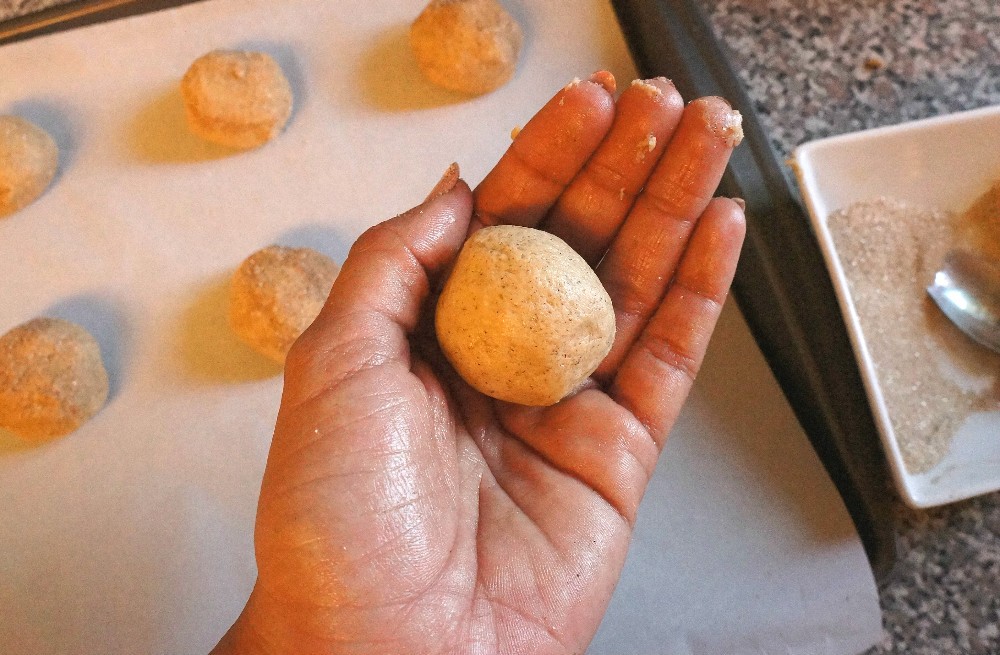Rolling the dough creates an easier reference of size. If a recipe calls for flattening with a sugar coated glass or fork, I’ll still roll them first to ensure that the pressed cookies are the same size. Rolling the dough into equal size balls also gives each cookie the same surface area.

How to flatten cookie dough with flair Share
So you’ve made the dough for sugar cookies and the recipe tells you to drop it in tablespoonfuls onto the baking sheet, then flatten each cookie with the bottom of a drinking glass (dipped in sugar so it doesn’t stick).
Pretty common step, right? Certain cookies — Sugar Cookies, Snickerdoodles, Classic Peanut Butter Cookies — need to be flattened a bit before they bake, lest they end up emerging from the oven looking like ping-pong balls rather than typical flat, round cookies.
But what’s the best way to do this?
Shortbread is usually baked in a mold or pan, but its equally delicious scooped into individual cookies.
Before we get into a mud-slinging match here about “the best way” to flatten cookies before baking, let me say this: there IS no best way. And there are no baking police: If your recipe tells you to flatten your cookies before baking, you just go ahead and do that however you want. So long as they end up evenly flat, that is; squashing cookies haphazardly under your palm means they may bake and brown unevenly.
Still, if you care deeply (or even casually) about the look of your cookies, you can take the flattening step as an opportunity for enhancement. The bottom of a glass works fine, it’s true. But think of all the ways beyond a smooth-bottom glass you might choose to flatten your cookies.
Classic Peanut Butter Cookies
For instance, I discovered long ago that the pusher from my Cuisinart food processor has a pattern of concentric circles on its end; this has become my go-to cookie dough flattener.
I also use a potato masher at times, whose parallel bars leave a stripy pattern. A meat mallet creates a sharp grid. A Kaiser roll stamp makes sweet little petaled flowers. And a tea strainer insert? Polka dots!
I know this is just plain common sense, but Ill remind you anyway: make sure whatever tool youre using is completely clean. If youre at all concerned, lay a square of plastic wrap over each cookie to protect it while pressing.
Classic Peanut Butter Cookies flattened with a meat mallet, food processor pusher, potato masher, and the traditional fork.
No, not all. Here are the attributes to look for when experimenting with imprints:
- The recipe calls for flattening the dough. If you’re not directed to flatten the dough before baking it means it’s soft enough to spread on its own, and the cookies won’t hold an imprint.
Shortbread dough scooped with a
- The dough is smooth, without chunky add-ins. For instance, chocolate chip or oatmeal raisin cookies are filled with chips, nuts, oats, and/or raisins, all of which will disrupt any pattern you might imprint.
- The recipe uses little or no leavening. The greater the amount of baking soda or baking powder in the recipe, the puffier the cookies will be. And puffiness is the enemy of a fine design atop cookies.
This dough for Classic Peanut Butter Cookies is quite stiff and dry: it holds an imprint nicely.
- The dough is fairly stiff. Sticky, soft dough is A) difficult to work with (your potato masher or salad fork will stick), and B) prone to flatten out more readily than stiffer dough during baking, and thus is less likely to retain its imprint.
- The recipe uses shortening. Cookies made with shortening (or a shortening-butter mix) rather than straight butter retain their pattern better. Shortening’s higher melting point means the cookies have a chance to set before the shortening melts, leaving the design intact. For more information see our post, Shortening vs. butter in baking.
A tea strainer makes pretty polka dots on these shortbread cookies, but its reach only extends so far. Cookies made with a teaspoon scoop are fully covered, while those made with a
If your recipe makes big, 4” cookies and all you have to flatten the dough balls is a 1 1/2” tea strainer, you’ll be left with cookies imprinted only in the center rather than edge to edge. You may decide this is fine; just be sure to manage your expectations when choosing your flattening tool.
A potato masher makes a pretty tree-like pattern on these shortbread cookies.
Center the tool directly over the middle of your cookie, and press straight down using even pressure. Be careful, though: press your Kaiser roll cutter too hard and itll cut completely through the dough, leaving you with random tear-shaped bits to piece together as best you can.
This spoon had potential, but in the end the scrollwork wasnt defined enough to leave a lasting pattern in shortbread dough.
So what if the scrolled handle of your mom’s antique silver serving spoon didn’t work? The etched top of the wine bottle stopper might! Roam around your house; are there office tools, barware, or knickknacks — any of which might work brilliantly — hiding in plain sight?
Gather a promising collection of tools, make a batch of dough, and imprint two or three cookies with each tool. If they come out of the oven looking great, cheers! Next time you’re flattening cookies you’ll know what to use.
Did the imprint disappear? No worries; enjoy the cookies anyway. After all, beauty is only crust deep.
Classic Peanut Butter Cookies, Shortbread (turned into drop cookies), and Snickerdoodles (flower shapes).
Have you found a flattening tool youre eager to try on your next batch of drop cookies? Start with our simple Shortbread recipe. Instead of pressing the dough into a pan, scoop it into balls (a teaspoon or tablespoon scoop works well). Flatten the dough balls and bake in a preheated 300°F oven for 25 to 30 minutes, or until the cookies are just beginning to brown around the edges. Enjoy your artwork! Share
Tips for perfect fruit scones.
Planet-friendly changes you can start making today.
A mashup cannoli cheesecake, a mind-blowing churro cupcake, and more.
Recipe of the Year 2024
See our complete collection of Tips and Techniques posts.

It is absolutely a trap. #Cookie. 
FAQ
How do you shape cookie dough into balls?
Why wont my cookie dough roll into a ball?
Can you reroll cookie dough?
Should you roll cookie dough into balls?
For edible cookie dough, rolling your freshly made recipe into balls helps the dough chill faster. It also makes the perfect size to pop in your mouth for fast and fun bite-sized flavor. As for bakeable cookie dough, these sphere shaped dough balls bake up more evenly when they are placed on a baking sheet this way.
Should chocolate chip cookie dough be rolled into balls before baking?
Yes, it is generally recommended that you form chocolate chip cookie dough, or any other dough flavor, into balls before baking. Aside from the aforementioned perks of doing so, remember also that rolling cookie dough into balls helps you control how much cookie dough you use.
How long do cookie dough balls last?
They can be stored for several weeks. When ready to enjoy, simply let them thaw in the refrigerator or at room temperature for a few minutes. Layering with Parchment: When storing in containers, layer the cookie dough balls with parchment paper to prevent them from sticking together. This makes it easier to grab a few at a time without any fuss.
How do you make chocolate chip cookie dough balls?
Cookie Dough Balls are sweet treats with edible chocolate chip cookie dough coated in melted semi-sweet chocolate. Line a baking sheet with parchment paper and remove the chilled cookie dough from the refrigerator. Scoop out the cookie dough with a one tablespoon scoop and roll it into a smooth ball. Place it on the parchment-lined baking sheet.
